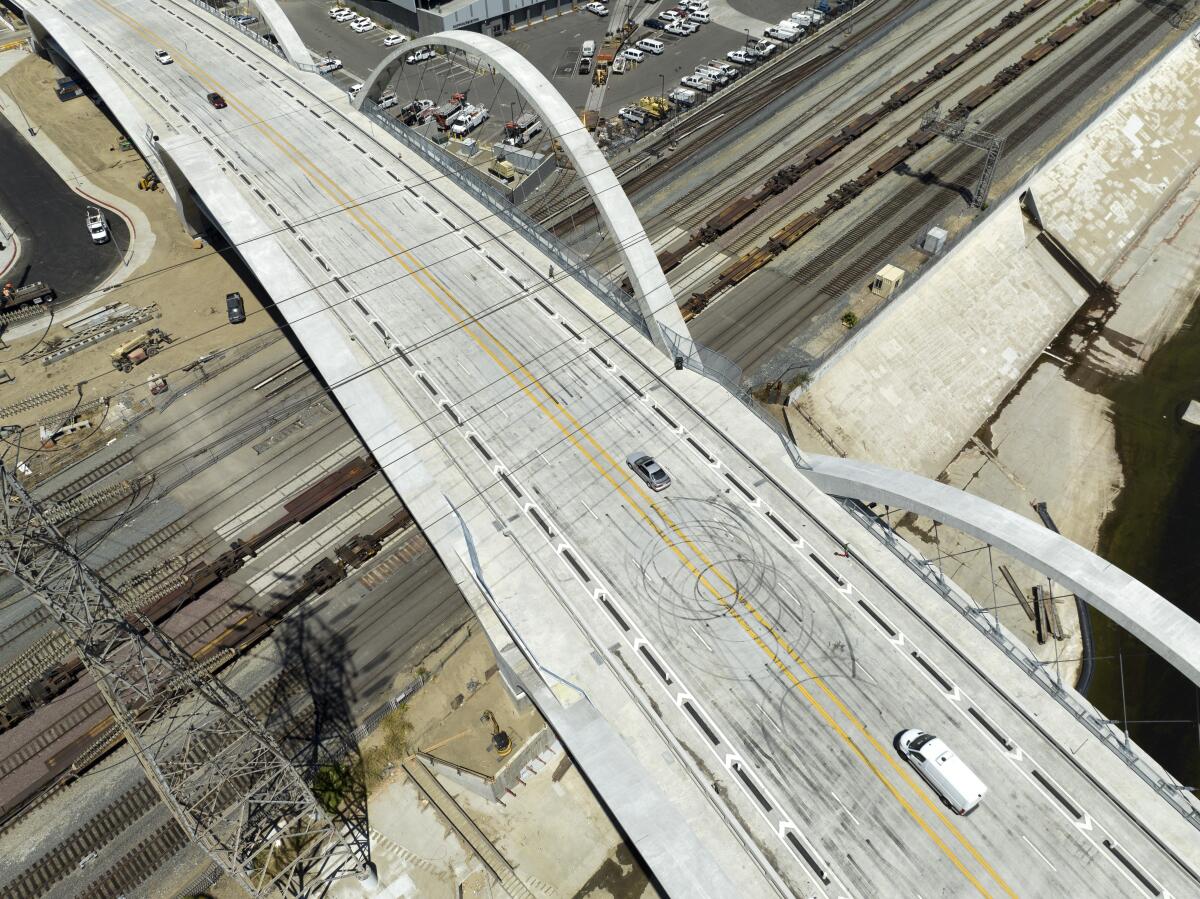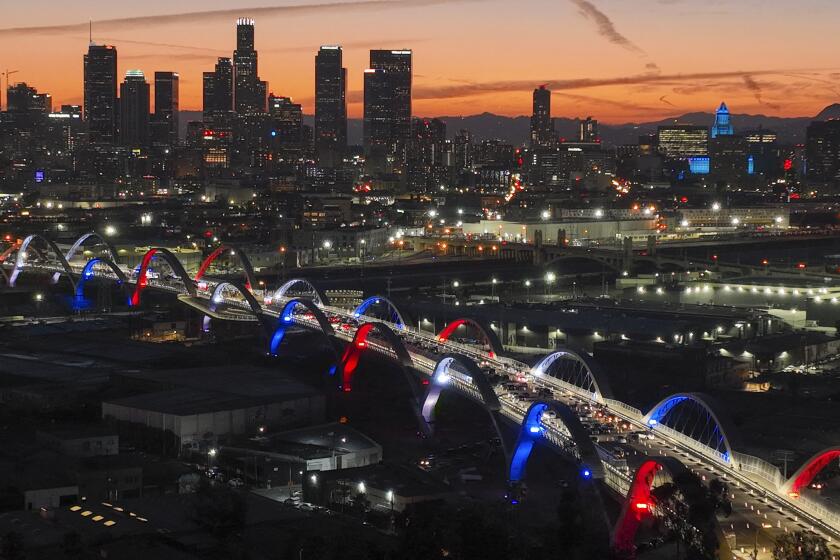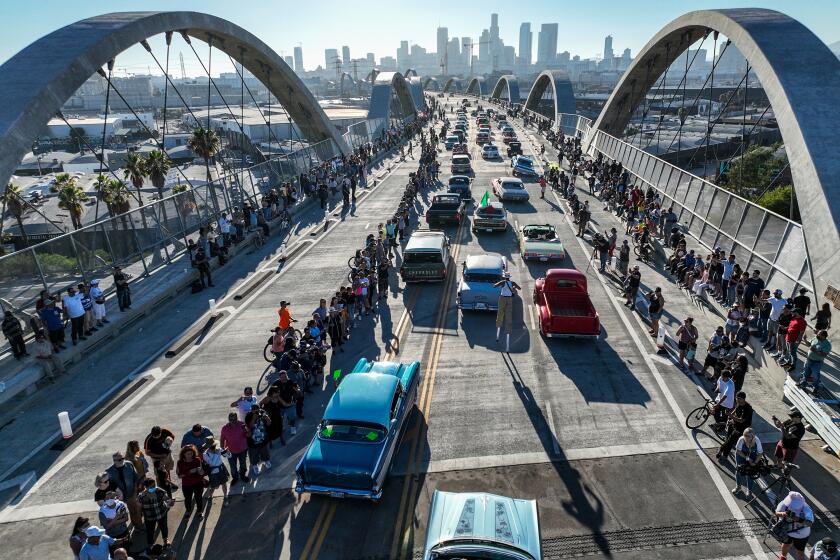The new 6th Street bridge’s baptism by L.A.: Street racers, skaters, taggers and a crash

The official opening party for the 6th Street Viaduct ended more than a week ago, but the bridge is now getting another inauguration, one from the citizens of Los Angeles.
Skateboarders, cruisers, taggers, street racers, scooter ditchers, bicyclists, tourists and plain old commuters are taking it from here.
The half-billion-dollar bridge is out of the lab and ready for the ecosystem to make its imprint — most visibly in the form of curlicue skid marks from drivers doing doughnuts and burnouts on its deck.
Over the weekend, daredevil skaters hurtled down its tall arches, risking potentially lethal falls. Spectators climbed up the same heights to watch a street takeover billow tire and brake smoke into the air. On Sunday the Los Angeles Police Department shut down the bridge — “again” — as they noted in a tweet. But the rumpus continued, as Monday brought another takeover and brief shutdown.
“This is the first bridge built in the Instagram era in L.A. — and as we’ve seen, people will do anything in the pursuit of virality,” said Eastside Councilman Kevin De Leon.
He pointed out that the drag racing is only part of the bridge’s story. “It’s been great to see people enjoying their bridge over the last week, from cool TikToks to stunning photos, this bridge is a lifeline — connecting Angelenos to opportunity, family and the future.”
On Tuesday his office said the city will add cameras on the bridge to deter and identify drag racers and other illegal activity. The LAPD has also added patrols, and transit officials are looking at putting in higher fencing and some kind of median that were not in the original plans.
For the record:
7:28 a.m. July 20, 2022An earlier version of this article misidentified a car in an Instagram video as a Hellcat Chevy. It was a Dodge Challenger.
During the takeover on Monday night, video posted on Instagram showed a white Dodge Challenger spinning its back wheels as it reared for the race. The driver slammed the gas and in an instant veered into oncoming and parked cars, hit a wall meant to separate pedestrians from traffic, then left the car and fled.
With its 10 pairs of tilted arches, it is the largest and most expensive bridge the city has ever erected.
Jessica Pugach, 21, was driving home when her Nissan Sentra was totaled in an instant. The force of impact knocked her into the passenger’s seat.
“If my car wasn’t stopped, I would’ve flown over the bridge,” she said. “I don’t even know how I’m alive right now.”
Pugach has made a plea on Instagram for witnesses who saw the crash, as well as people familiar with the takeover community, for help in identifying the driver. No one has been able to confirm the identity of the driver, she said.
Official hope the $588-million bridge will be more venerable icon than urban Thunderdome — akin to the Golden Gate or Brooklyn bridges. But Los Angeles — birthplace of skater and lowrider cultures, land of commuters, taggers and Insta influencers — has a way of spinning its own stories.
“Cities have their goal, their intentions of what that bridge means to them,” said Denise Sandoval, a professor at Cal State Northridge and a veteran researcher and curator of lowrider culture. “But the people will make meaning out of public spaces ... and maybe it doesn’t always align with the city.”
In many ways, the drama playing out along the bridge and around it reflect the tensions in the city. Many of the lowriders are frustrated with drag racers who create a safety issue and call police attention to their gatherings, she said. Vocal cyclists are upset with the design of the unprotected biking path. And city crews have to paint over graffiti every day.
“It’s like the people are starting to make meaning out of that bridge,” she said.
Frank Gallegos, who lives a few blocks from the bridge, watched over the weekend as traffic from cruisers clogged up Whittier Boulevard.
“It’s just all the hype, everyone is all mesmerized by it,” he said. The next morning, he like other day trippers came out to take in the sweeping view of the city and walk along the bridge. Boxes of burnt fireworks were scattered. Skid marks stained the fresh concrete. And a few abandoned rented scooters sat in the bike lane. Police were cracking down on drivers who pulled over to take pictures, as joggers, cyclists and cars streamed by.
“I am loving the bridge even though it’s only been two weeks,” he said.
Photos show the 6th Street Viaduct in downtown Los Angeles opening to pedestrians and then vehicle traffic.
The Sixth Street Viaduct is the largest and most expensive bridge the city has ever erected, connecting downtown to Whittier Boulevard, the heart of the historic Eastside.
“It kind of gives me Brooklyn bridge vibes,” said Michele Phu, 30, an Arts District bartender who stopped to sip water as she ran across the bridge. “I just love seeing everyone outside on their bikes and walking the bridge.”
More than just a route into downtown, the bridge connects the Eastside community that for decades has been economically and racially segregated from other parts of Los Angeles.
Eric Avila, an urban historian at UCLA, said watching the images on television of the burnouts bristled him, harking back to the lawless portrait of the Eastside often portrayed decades ago, when the Los Angeles County sheriff would shut down Whittier Boulevard for long stretches because of cruising.
“Now, given the scope and the frequency of that activity, why should we be surprised that it’s now on this shiny new bridge?” he said. “The dynamic exists in most every modern city, around the world you know, people using these spaces in ways that were not intended by the designers or the sponsors of new spaces.”
He sees the bridge as a hopeful sign. “It’s a fitting beginning or end to Whittier Boulevard, which historically is the heart of Mexican American Los Angeles. The bridge is symbolic of reconnecting or reintegrating that community into the larger civic fabric.”
Not everyone sees the structure as kindly.
“It’s like a really beautiful glorified freeway basically,” said James Rojas, an urban planner and artist who looks at Latino cultural influences on urban design. Burning hot during the summer, the concrete bridge has little shade and is largely made for cars.
The bridge, he said, can make a beautiful picture from a loft in the Arts District, but it is the antithesis of the landscape around East Los Angeles, where immigrants and generations of families often find solace in small gardens and intimate spaces. Instead, he said the structure is harsh, “more about the spectacle than the practicality.”
The viaduct replaced a Depression-era bridge demolished in 2016 because its concrete was crumbling. The location of the span has long offered a picturesque spot capturing both the concrete arches and the city backdrop: freeways, skyscrapers, palm trees, little homes hugging the hills.
“Los Angeles is one of the most highly segregated cities in the country,” said Anne LaBorde, 70, a retired healthcare manager from West Hollywood who came to walk the bridge with her nephew and best friends. “So anything that L.A. does to bring its communities together, I am for. I happen to love graffiti.”
She also knows it will get painted over.
“But it’s Los Angeles. Nobody’s ever going to stop putting graffiti.”
More to Read
Sign up for Essential California
The most important California stories and recommendations in your inbox every morning.
You may occasionally receive promotional content from the Los Angeles Times.














